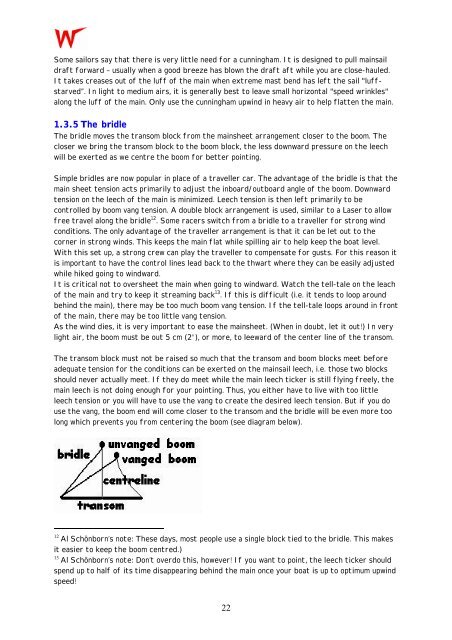File - Canadian Wayfarer Association
File - Canadian Wayfarer Association
File - Canadian Wayfarer Association
You also want an ePaper? Increase the reach of your titles
YUMPU automatically turns print PDFs into web optimized ePapers that Google loves.
Some sailors say that there is very little need for a cunningham. It is designed to pull mainsail<br />
draft forward – usually when a good breeze has blown the draft aft while you are close-hauled.<br />
It takes creases out of the luff of the main when extreme mast bend has left the sail "luffstarved”.<br />
In light to medium airs, it is generally best to leave small horizontal "speed wrinkles"<br />
along the luff of the main. Only use the cunningham upwind in heavy air to help flatten the main.<br />
1.3.5 The bridle<br />
The bridle moves the transom block from the mainsheet arrangement closer to the boom. The<br />
closer we bring the transom block to the boom block, the less downward pressure on the leech<br />
will be exerted as we centre the boom for better pointing.<br />
Simple bridles are now popular in place of a traveller car. The advantage of the bridle is that the<br />
main sheet tension acts primarily to adjust the inboard/outboard angle of the boom. Downward<br />
tension on the leech of the main is minimized. Leech tension is then left primarily to be<br />
controlled by boom vang tension. A double block arrangement is used, similar to a Laser to allow<br />
free travel along the bridle 12 . Some racers switch from a bridle to a traveller for strong wind<br />
conditions. The only advantage of the traveller arrangement is that it can be let out to the<br />
corner in strong winds. This keeps the main flat while spilling air to help keep the boat level.<br />
With this set up, a strong crew can play the traveller to compensate for gusts. For this reason it<br />
is important to have the control lines lead back to the thwart where they can be easily adjusted<br />
while hiked going to windward.<br />
It is critical not to oversheet the main when going to windward. Watch the tell-tale on the leach<br />
of the main and try to keep it streaming back 13 . If this is difficult (i.e. it tends to loop around<br />
behind the main), there may be too much boom vang tension. If the tell-tale loops around in front<br />
of the main, there may be too little vang tension.<br />
As the wind dies, it is very important to ease the mainsheet. (When in doubt, let it out!) In very<br />
light air, the boom must be out 5 cm (2'), or more, to leeward of the center line of the transom.<br />
The transom block must not be raised so much that the transom and boom blocks meet before<br />
adequate tension for the conditions can be exerted on the mainsail leech, i.e. those two blocks<br />
should never actually meet. If they do meet while the main leech ticker is still flying freely, the<br />
main leech is not doing enough for your pointing. Thus, you either have to live with too little<br />
leech tension or you will have to use the vang to create the desired leech tension. But if you do<br />
use the vang, the boom end will come closer to the transom and the bridle will be even more too<br />
long which prevents you from centering the boom (see diagram below).<br />
12<br />
Al Schönborn’s note: These days, most people use a single block tied to the bridle. This makes<br />
it easier to keep the boom centred.)<br />
13<br />
Al Schönborn’s note: Don’t overdo this, however! If you want to point, the leech ticker should<br />
spend up to half of its time disappearing behind the main once your boat is up to optimum upwind<br />
speed!<br />
22


